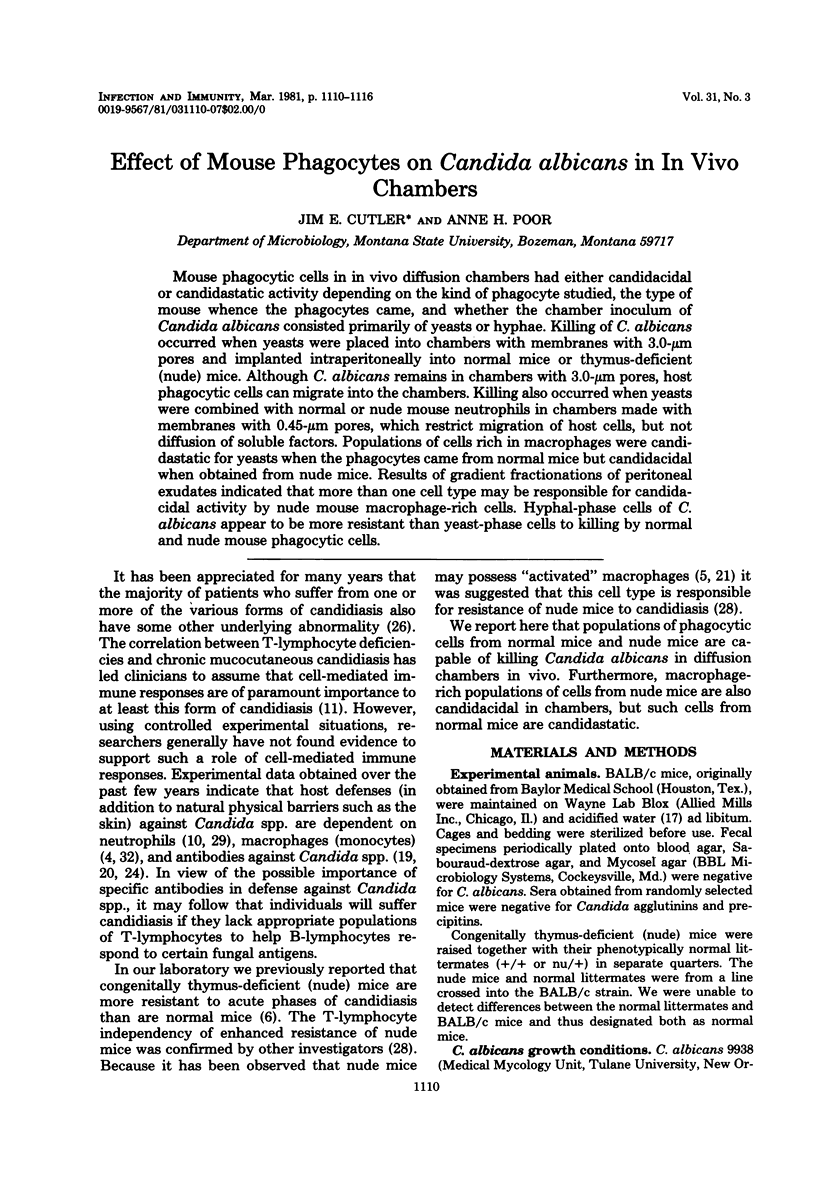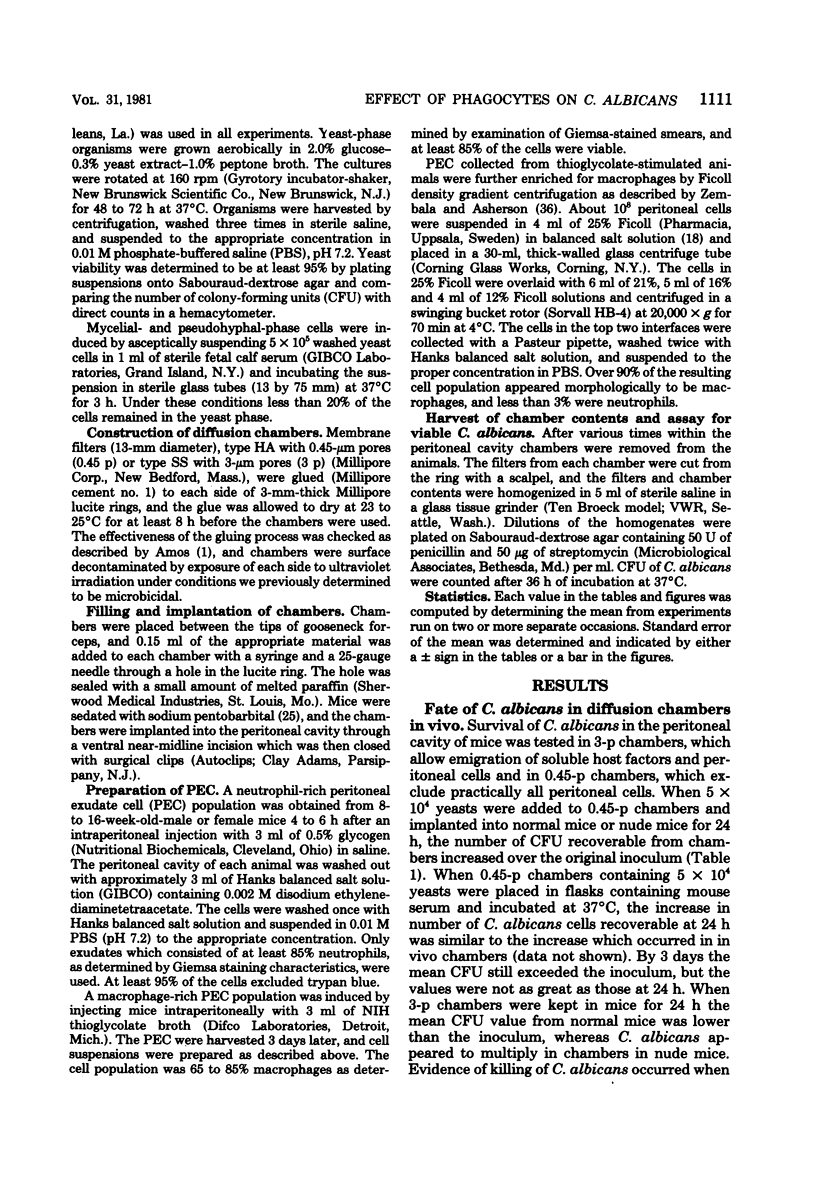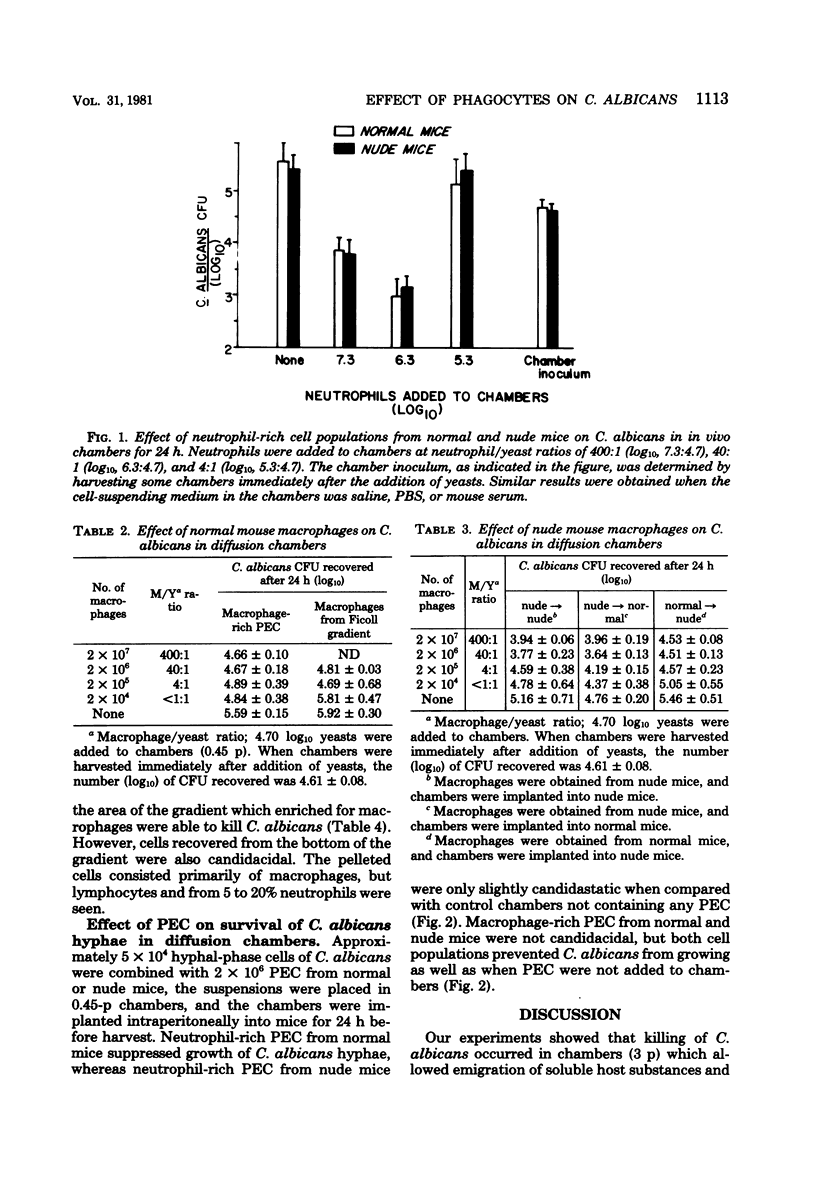Abstract
Mouse phagocytic cells in in vivo diffusion chambers had either candidacidal or candidastatic activity depending on the kind of phagocyte studied, the type of mouse whence the phagocytes came, and whether the chamber inoculum of Candida albicans consisted primarily of yeasts or hyphae. Killing of C. albicans occurred when yeasts were placed into chambers with membranes with 3.0-micrometer pores and implanted intraperitoneally into normal mice or thymus-deficient (nude) mice. Although C. albicans remains in chambers with 3.0-micrometer pores, host phagocytic cells can migrate into the chambers. Killing also occurred when yeasts were combined with normal or nude mouse neutrophils in chambers made with membranes with 0.45-micrometer pores, which restrict migration of host cells, but not diffusion of soluble factors. Populations of cells rich in macrophages were candidastatic for yeasts when the phagocytes came from normal mice but candidacidal when obtained from nude mice. Results of gradient fractionations of peritoneal exudates indicated that more than one cell type may be responsible for candidacidal activity by nude mouse macrophage-rich cells. Hyphal-phase cells of C. albicans appear to be more resistant than yeast-phase cells to killing by normal and nude mouse phagocytic cells.
Full text
PDF






Selected References
These references are in PubMed. This may not be the complete list of references from this article.
- Arai T., Mikami Y., Yokoyama K. Phagocytosis of Candida albicans by rabbit alveolar macrophages and guinea pig neutrophils. Sabouraudia. 1977 Jul;15(2):171–177. [PubMed] [Google Scholar]
- Belcher R. W., Carney J. F., Monahan F. G. An electron microscopic study of phagocytosis of Candida albicans by polymorphonuclear leukocytes. Lab Invest. 1973 Dec;29(6):620–627. [PubMed] [Google Scholar]
- Cutler J. E. Acute systemic candidiasis in normal and congenitally thymic-deficient (nude) mice. J Reticuloendothel Soc. 1976 Feb;19(2):121–124. [PubMed] [Google Scholar]
- DeMaria A., Buckley H., von Lichtenberg F. Gastrointestinal candidiasis in rats treated with antibiotics, cortisone, and azathioprine. Infect Immun. 1976 Jun;13(6):1761–1770. doi: 10.1128/iai.13.6.1761-1770.1976. [DOI] [PMC free article] [PubMed] [Google Scholar]
- Diamond R. D., Krzesicki R., Jao W. Damage to pseudohyphal forms of Candida albicans by neutrophils in the absence of serum in vitro. J Clin Invest. 1978 Feb;61(2):349–359. doi: 10.1172/JCI108945. [DOI] [PMC free article] [PubMed] [Google Scholar]
- Hurley R., Stanley V. C. Cytopathic effects of pathogenic and non-pathogenic species of Candida on cultured mouse epithelial cells: relation to the growth rate and morphology of the fungi. J Med Microbiol. 1969 Feb;2(1):63–74. doi: 10.1099/00222615-2-1-63. [DOI] [PubMed] [Google Scholar]
- Hurtrel B., Lagrange P. H., Michel J. C. Systemic candidiasis in mice. II.--Main role of polymorphonuclear leukocytes in resistance to infection. Ann Immunol (Paris) 1980 Jan-Feb;131C(1):105–118. [PubMed] [Google Scholar]
- Kirkpatrick C. H., Rich R. R., Bennett J. E. Chronic mucocutaneous candidiasis: model-building in cellular immunity. Ann Intern Med. 1971 Jun;74(6):955–978. doi: 10.7326/0003-4819-74-6-955. [DOI] [PubMed] [Google Scholar]
- Lehrer R. I., Cline M. J. Interaction of Candida albicans with human leukocytes and serum. J Bacteriol. 1969 Jun;98(3):996–1004. doi: 10.1128/jb.98.3.996-1004.1969. [DOI] [PMC free article] [PubMed] [Google Scholar]
- Lehrer R. I., Ferrari L. G., Patterson-Delafield J., Sorrell T. Fungicidal activity of rabbit alveolar and peritoneal macrophages against Candida albicans. Infect Immun. 1980 Jun;28(3):1001–1008. doi: 10.1128/iai.28.3.1001-1008.1980. [DOI] [PMC free article] [PubMed] [Google Scholar]
- Lehrer R. I. Measurement of candidacidal activity of specific leukocyte types in mixed cell populations I. Normal, myeloperoxidase-deficient, and chronic granulomatous disease neutrophils. Infect Immun. 1970 Jul;2(1):42–47. doi: 10.1128/iai.2.1.42-47.1970. [DOI] [PMC free article] [PubMed] [Google Scholar]
- Lehrer R. I. The fungicidal mechanisms of human monocytes. I. Evidence for myeloperoxidase-linked and myeloperoxidase-independent candidacidal mechanisms. J Clin Invest. 1975 Feb;55(2):338–346. doi: 10.1172/JCI107937. [DOI] [PMC free article] [PubMed] [Google Scholar]
- MCPHERSON C. W. REDUCTION OF PSEUDOMONAS AERUGINOSA AND COLIFORM BACTERIA IN MOUSE DRINKING WATER FOLLOWING TREATMENT WITH HYDROCHLORIC ACID OR CHLORINE. Lab Anim Care. 1963 Oct;13:737–744. [PubMed] [Google Scholar]
- Mardon D. N., Gunn J. L., Robinette E., Jr Variation in the lethal response in mice to yeast-like and pseudohyphal forms of Candida albicans. Can J Microbiol. 1975 Nov;21(11):1681–1687. doi: 10.1139/m75-246. [DOI] [PubMed] [Google Scholar]
- Mishell R. I., Dutton R. W. Immunization of dissociated spleen cell cultures from normal mice. J Exp Med. 1967 Sep 1;126(3):423–442. doi: 10.1084/jem.126.3.423. [DOI] [PMC free article] [PubMed] [Google Scholar]
- Moser S. A., Domer J. E. Effects of cyclophosphamide on murine candidiasis. Infect Immun. 1980 Feb;27(2):376–386. doi: 10.1128/iai.27.2.376-386.1980. [DOI] [PMC free article] [PubMed] [Google Scholar]
- Mourad S., Friedman L. Passive immunization of mice against Candida albicans. Sabouraudia. 1968 Feb;6(2):103–105. [PubMed] [Google Scholar]
- Nickol A. D., Bonventre P. F. Anomalous high native resistance to athymic mice to bacterial pathogens. Infect Immun. 1977 Dec;18(3):636–645. doi: 10.1128/iai.18.3.636-645.1977. [DOI] [PMC free article] [PubMed] [Google Scholar]
- Oblack D., Schwarz J., Holder I. A. Biochemical examination of sera during systemic Candida infection in mice. Infect Immun. 1978 Mar;19(3):992–998. doi: 10.1128/iai.19.3.992-998.1978. [DOI] [PMC free article] [PubMed] [Google Scholar]
- Ozato K., Uesaka I. The role of macrophages in Candida albicans infection in vitro. Jpn J Microbiol. 1974 Jan;18(1):29–35. doi: 10.1111/j.1348-0421.1974.tb00740.x. [DOI] [PubMed] [Google Scholar]
- PILGRIM H. I., DEOME K. B. Intraperitoneal pentobarbital anesthesia in mice. Exp Med Surg. 1955;13(4):401–403. [PubMed] [Google Scholar]
- Pearsall N. N., Adams B. L., Bunni R. Immunologic responses to Candida albicans. III. Effects of passive transfer of lymphoid cells or serum on murine candidiasis. J Immunol. 1978 Apr;120(4):1176–1180. [PubMed] [Google Scholar]
- Rogers T. J., Balish E., Manning D. D. The role of thymus-dependent cell-mediated immunity in resistance to experimental disseminated candidiasis. J Reticuloendothel Soc. 1976 Oct;20(4):291–298. [PubMed] [Google Scholar]
- Rogers T. J., Balish E. The role of activated macrophages in resistance to experimental renal candidiasis. J Reticuloendothel Soc. 1977 Oct;22(4):309–318. [PubMed] [Google Scholar]
- Ruthe R. C., Andersen B. R., Cunningham B. L., Epstein R. B. Efficacy of granulocyte transfusions in the control of systemic candidiasis in the leukopenic host. Blood. 1978 Sep;52(3):493–498. [PubMed] [Google Scholar]
- Saltarelli C. G., Gentile K. A., Mancuso S. C. Lethality of Candida strains as influenced by the host. Can J Microbiol. 1975 May;21(5):648–654. doi: 10.1139/m75-093. [DOI] [PubMed] [Google Scholar]
- Sasada M., Johnston R. B., Jr Macrophage microbicidal activity. Correlation between phagocytosis-associated oxidative metabolism and the killing of Candida by macrophages. J Exp Med. 1980 Jul 1;152(1):85–98. doi: 10.1084/jem.152.1.85. [DOI] [PMC free article] [PubMed] [Google Scholar]
- Schuit K. E. Phagocytosis and intracellular killing of pathogenic yeasts by human monocytes and neutrophils. Infect Immun. 1979 Jun;24(3):932–938. doi: 10.1128/iai.24.3.932-938.1979. [DOI] [PMC free article] [PubMed] [Google Scholar]
- Stanley V. C., Hurley R. The growth of Candida species in cultures of mouse peritoneal macrophages. J Pathol. 1969 Feb;97(2):357–366. doi: 10.1002/path.1710970222. [DOI] [PubMed] [Google Scholar]
- YOUNG G. The process of invasion and the persistence of Candida albicans injected intraperitoneally into mice. J Infect Dis. 1958 Mar-Apr;102(2):114–120. doi: 10.1093/infdis/102.2.114. [DOI] [PubMed] [Google Scholar]
- Yamamura M., Valdimarsson H. Participation of C3 in intracellular killing of Candida albicans. Scand J Immunol. 1977;6(6-7):591–594. doi: 10.1111/j.1365-3083.1977.tb02137.x. [DOI] [PubMed] [Google Scholar]
- Zembala M., Asherson G. L. The rapid purification of peritoneal exudate macrophages by ficoll (polysucrose) density gradient centrifugation. Immunology. 1970 Oct;19(4):677–681. [PMC free article] [PubMed] [Google Scholar]


